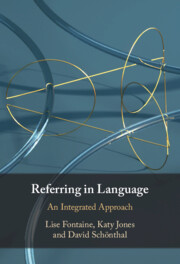Book contents
- Referring in Language
- Referring in Language
- Copyright page
- Contents
- Figures
- Tables
- Acknowledgements
- Part I The Nature of Referring and Referring Expressions
- Part II Typical Reference
- Part III Atypical Reference
- 7 Referring in Non-collaborative Contexts
- 8 Indefinite Expressions for Referring Definitely
- 9 Child’s Play
- 10 Reference and Metonymy
- 11 Epilogue
- References
- Index
8 - Indefinite Expressions for Referring Definitely
from Part III - Atypical Reference
Published online by Cambridge University Press: 22 June 2023
- Referring in Language
- Referring in Language
- Copyright page
- Contents
- Figures
- Tables
- Acknowledgements
- Part I The Nature of Referring and Referring Expressions
- Part II Typical Reference
- Part III Atypical Reference
- 7 Referring in Non-collaborative Contexts
- 8 Indefinite Expressions for Referring Definitely
- 9 Child’s Play
- 10 Reference and Metonymy
- 11 Epilogue
- References
- Index
Summary
This chapter provides a detailed account of the atypical use of a certain type of indefinite referring expression. Contrary to the established view that indefinite expressions cannot be used for uniquely identifiable reference, we show that this is not always the case. Using written texts from opinion writing in newspaper discourse, we detail how writers can create an adequately definite shared space with their readers to allow an indefinite expression to be understood as referring to an established entity. The cotextual and contextual scaffolding put in place by the writer is sufficient for the indefinite expression to be understood as identifiable. The chapter also discusses the reasons why a writer would want to override normal accessibility considerations. Writers use these atypical expressions to ensure the association to an old, identifiable referent remains explicit by exploiting contextually and co-textually established information which is tied to the context or ongoing discourse.
Keywords
Information
- Type
- Chapter
- Information
- Referring in LanguageAn Integrated Approach, pp. 150 - 174Publisher: Cambridge University PressPrint publication year: 2023
